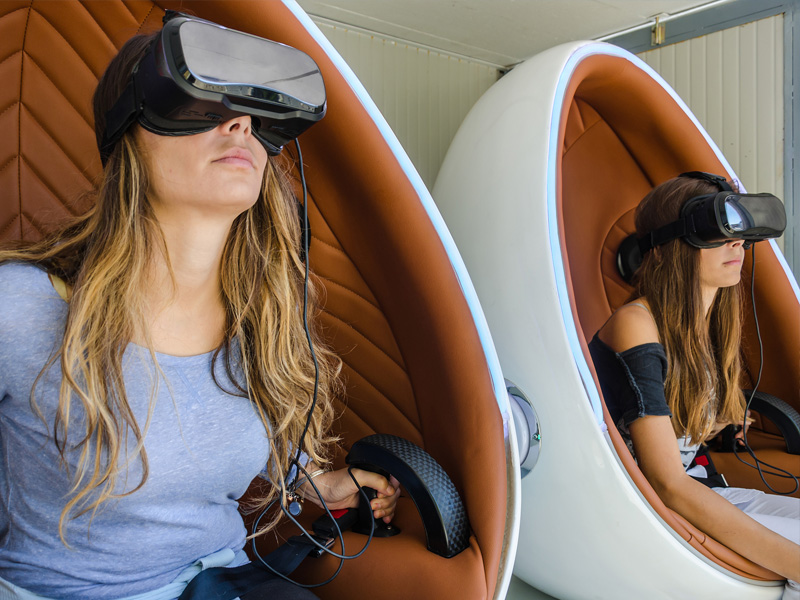By Ben Fineman
Virtual and augmented reality technologies are promising to revolutionise the way we present and experience information, which will have profound implications for educational institutions. This article discusses the current state of these technologies and their educational applications today, as well as exploring the exciting future possibilities they will enable.
It’s no secret that the rapid pace of technological advancement is providing unprecedented challenges and opportunities for primary, secondary, and higher education institutions. Schools and universities alike are facing the fact that traditional “stand and deliver” pedagogies, where students passively absorb information presented by a lecturer, are often not the best way to achieve optimal learning outcomes. In the past decade, academic institutions have made significant advances in improving these outcomes through the implementation of new teaching methods enabled by technologies such as real-time video collaboration, online video platforms, learning management systems, and one-to-one digital devices. These and other technologies have empowered students to more effectively leverage information sources both in and out of the classroom, with improvements in learning outcomes to show for it.1 But the improvements we’ve witnessed to date are only the tip of the iceberg. As the exponential advancement of technology continues, a new set of emerging devices is promising to shift the educational paradigm more significantly than anything else to date: virtual reality (VR) and augmented reality (AR).
Virtual reality is not a new idea. We can look as far back as 1961 with the introduction of the Philco Headsight, an early head mounted display designed to be used with closed circuit TV for remotely viewing dangerous situations. The education community itself is no stranger to VR – in 1992, the University of Illinois, Chicago Electronic Visualization Lab invented the CAVE (CAVE Automatic Virtual Environment).2 This system used a room full of projectors and screens along with motion tracking to create an immersive virtual reality experience, and was deployed at a number of research universities, but did not achieve wide adoption largely due to the significant investment in equipment and expertise required to build and operate. Universities are still deploying updated versions of this system today, with a recent example being the YURT (YURT Ultimate Reality Theater) at Brown University,3 which includes sixty-nine high definition projectors driven by twenty nodes of a high performance computing cluster.
[ms-protect-content id=”9932″]Exponential technology advancement has created a confluence of capabilities – high definition flat panel displays, high performance processors, and high bandwidth connections, to name a few – that have enabled the production of consumer-available immersive VR devices. The first of these devices to gain mainstream attention was the Oculus Rift – starting with a successful Kickstarter campaign in 2012, this device achieved heavyweight financial backing in 2014 with a $2 Billion USD acquisition by Facebook. The Rift ostensibly opened the floodgates in the consumer VR market, and today there are many competing head mounted displays available, though the Oculus Rift and HTC Vive remain the leaders in the space. The net result is that today anyone can access an immersive VR experience about $399 USD. This is a far cry from the previous $100,000+ USD price of entry associated with CAVE systems, and now makes VR available not only to many consumers, but also to many more educational institutions.
It’s important to also note the range of low end VR displays that are now available, the most notable of which is the Google Cardboard platform. These devices (which can literally be made of cardboard) leverage any compatible smartphone to create a rudimentary VR experience for as little as $10 USD. These “smartphone holder” platforms lower the cost of entry by another order of magnitude, but provide only a glimpse into the potential of VR as opposed to the immersive experiences that dedicated head mounted displays can provide. Nonetheless, educational institutions with limited budgets, particularly primary and secondary institutions, are finding success with these low cost devices.
Now that educational institutions have access to this diverse and robust array of virtual reality devices, what are they doing with them? Applications are limited, for the most part, only by our own creativity. Following is a collection of some of the most common uses of VR in education today.
• Field Trips. This one is perhaps the most obvious – these technologies enable students to virtually visit locations that they aren’t able to physically visit – ranging from the Smithsonian museums,4 to the Amazon rain forest,5 to the surface of Mars.6 While the education community has long conducted virtual field trips using video technology, VR is enhancing student engagement and outcomes through increased immersion.
• Distance Learning. After years of working with video conferencing, I’m very excited to see how virtual reality technology is going to enhance distance learning. A professor at the University of British Columbia has already delivered lectures in VR,7 complete with full body motion capture mapped to an avatar. The Stanford School of business is offering a certificate programme delivered entirely via VR. Students and faculty at Penn State have shown how implementing VR can improve learning outcomes via traditional online methods.
• Design. Perhaps one of the best early uses of virtual reality is in architecture – being able to visit and explore a building before any construction actually begins is a huge step forward for this field. Drury University is one of many architecture programmes beginning to take advantage of this technology. But this design application isn’t limited to the architecture field – in one of my favourite examples, primary school students in Ireland are using VR to recreate and visit Irish historical sites.
• Training. It’s well known that many people learn more effectively by doing as opposed to just seeing or hearing. VR gives students the opportunity to experience the activities they are learning about, whether that is working an archeological dig site, guiding airplane landings on an aircraft carrier, or conducting surgical procedures.
• Recruiting. When choosing which college to attend students like to do campus visits to get a better feel for the institution. Some schools are making this easier on students by offering virtual campus visits. Taking the concept a step further, other institutions are using virtual reality as a way to entice college athletes – one example is the University of Michigan Football programme, that gives potential recruits a chance to feel what it’s like to play in America’s largest stadium in front of 107,000+ screaming fans.
• Collaboration. This is perhaps the most important way VR is being used, because it has implications not only for research and education, but for all of us. Virtual reality is going to change the way we collaborate over distance. The University College of London’s Immersive Virtual Environment demonstrated how interactive virtual avatars can be mapping onto local physical spaces using augmented reality, as has UC Davis. Case Western has been working with Microsoft to prototype collaborative medical applications for the Hololens augmented reality platform. All of the pieces are coming together to see the collaborative promise of virtual reality realised.
Virtual Reality and the Future of Education
Before we can look very far into the future, there is another type of technology that is necessary to discuss: augmented reality (AR). AR, unlike VR, does not obscure and replace the user’s physical environment with a virtual one, but rather overlays virtual elements on top of the real environment. The best consumer-available example today is Microsoft’s Hololens, although its relatively steep price point of $3,000 USD combined with the current “beta” nature of the experience limits adoption. But the important thing to understand is that virtual reality and augmented reality are two ends of the same spectrum, varying only by how much of the physical world is virtually replaced. Eventually, these devices will converge into something that will be able to replace as much or as little of the real world as a given application requires.
The future of education with respect to VR and AR has the potential to be nothing short of transformative. Pedagogy has always been limited by the way we are able to present information: the printed word, photograph, video and audio recordings represented leaps forward over the past decades and centuries. But today’s digital devices, for the most part, just take old information paradigms and make them more accessible. How different, after all, is a web page from the printed page of a book?
Virtual and augmented reality is causing a paradigm shift by presenting information in a fundamentally different way: by immersing the user inside it. It’s no secret that many of the most effective pedagogies put the learner directly in the environment or the activity of study – for example, there is no better way to learn about Italian architecture than to visit the cathedrals and palaces of Rome and Florence, and there is no better way to learn how to assemble a widget than to actually assemble it. But today, for many subjects this isn’t possible because of cost or logistics. VR/AR has the promise to change this by enabling learners to be immersed in nearly any subject from any location at any time.
Further – we know that another component of education is collaboration, not only with instructors and topic experts, but also with peers. We have seen advancements in video collaboration technology begin to yield dividends as students complete homework and projects in distributed groups, and engage teachers in distance learning. But we also know that the most effective collaborations happens in person, which is why the efficacy of even the best video conferencing technology still falls short of real life interactions. VR/AR is poised to revolutionise education by providing learners with a level of immersion in their remote collaborations that was not previously possible.
Finally, and perhaps most promisingly, VR/AR’s new capabilities in presenting information will yield new pedagogies that have never been previously possible. For example, students at the Mendel Grammar School in Opava City, Czech Republic have used virtual reality to travel inside and manipulate the anatomy of the human eye8 – this ability to physically manipulate the parts and see how they work together is something not previously possible. How might these new capabilities revolutionise the teaching of other subjects? The possibilities are limited only by the creativity of our current and future educators.
With the new capabilities that virtual and augmented reality will provide, the future of education is bright. However, as with any technology the ultimate efficacy in improving student outcomes lies not with the technology itself, but with those who implement the programmes that the technology enables. The speed of technological advancement today is such that no one person or even one institution can keep up with everything. To most effectively deploy these emerging technologies in real teaching environments, the education community must collaborate cross institutionally and learn from each other to develop and implement use cases and best practices. Fortunately, collaboration is something that our community does quite well – I look forward to seeing what we can achieve together.
[/ms-protect-content]
About the Author
 Ben Fineman works at the non-profit network consortium Internet2 enacting positive change for the academic community through the deployment and development of advanced collaboration technologies. From traditional video conferencing to collaborative virtual reality, Ben works to improve outcomes with universities, colleges, and community anchor institutions around the world.
Ben Fineman works at the non-profit network consortium Internet2 enacting positive change for the academic community through the deployment and development of advanced collaboration technologies. From traditional video conferencing to collaborative virtual reality, Ben works to improve outcomes with universities, colleges, and community anchor institutions around the world.
References
1. Bishop, Jacob Lowell, and Matthew A. Verleger. “The flipped classroom: A survey of the research.”ASEE National Conference Proceedings, Atlanta, GA. Vol. 30. No. 9. 2013.
2. Carolina Cruz-Neira, Daniel J. Sandin, Thomas A. DeFanti, Robert V. Kenyon, and John C. Hart. 1992. The CAVE: audio visual experience automatic virtual environment. ACM35, 6 (June 1992), 64-72. DOI=http://dx.doi.org/10.1145/129888.129892
3. (n.d.). Retrieved July 28, 2017, from https://web1.ccv.brown.edu/viz-yurt
4. NMNH Virtual Tour. (n.d.). Retrieved July 31, 2017, from http://naturalhistory.si.edu/vt3/
5. This edtech startup is bringing virtual reality to the classroom By Stephen Babcock / reporter. (2015, May 29). This edtech startup is bringing virtual reality to the classroom. Retrieved July 31, 2017, from https://technical.ly/baltimore/2015/05/29/alchemy-learning-virtual-reality-classroom-oculus/
6. Kyle Orland – Oct 3, 2013 7:00 pm UTC, & ThinineArs Tribunus Militum jump to post. (2013, October 03). How gaming tech is making for better interplanetary exploration. Retrieved July 31, 2017, from http://arstechnica.com/science/2013/10/how-gaming-tech-is-making-for-better-interplanetary-exploration/
7. James, P. (2014, November 28). “VR Chat” Used to Deliver One of the First University Lectures in Virtual Reality. Retrieved July 31, 2017, from www.roadtaovr.com/vr-chat-helps-deliver-first-virtual-university-lecture/
8. James, P. (2016, July 29). This is the Beginning of VR Education, and It Will Only Get Better – Road to VR. Retrieved July 31, 2017, from www.roadtovr.com/world-of-comenius-virtual-reality-education-biology-lesson-leap-motion-oculus-rift-dk2/



































